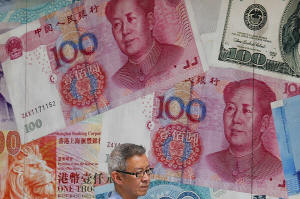Asian Development Bank raises growth forecast for region, but warns of
risks from trade sanctions
 Send a link to a friend
Send a link to a friend
 [September 25, 2024] By
ELAINE KURTENBACH [September 25, 2024] By
ELAINE KURTENBACH
Developing economies in Asia are forecast to grow at a 5.0% annual pace
this year, helped by a strong U.S. economy and surging demand for
computer chips that power artificial intelligence, the Asian Development
Bank said in a report Wednesday.
The forecast was revised upward slightly from the ADB's April estimate
of 4.9% growth.
However, the regional lender warned of the potential threat of more
protectionist measures, such as higher tariffs on exports from China,
depending on the outcome of the U.S. presidential election.
The report highlighted several positive trends, including a rebound in
exports from Asia of computer chips and other advanced electronics this
year due to rapid adoption of artificial intelligence. It also noted
that energy and food prices are moderating, though inflation remains
painfully high in countries such as Pakistan, Laos and Myanmar.
The upturn in global demand for semiconductors and related electronics
materials and components has helped drive stronger growth in Taiwan,
Hong Kong, Singapore and South Korea, and to a lesser extent, the
Philippines and Thailand, and that trend is expected to continue.

The report cited data from World Semiconductor Trade Statistics
projecting that spending on memory chips, vital for AI applications,
will expand 77% this year.
Other types of exports, especially autos from China and South Korea,
also are growing quickly, it said.
The U.S. presidential election is a major source of uncertainty.
“The election could result in higher blanket tariffs by the U.S. on all
global imports, and a broad-based and steep increase in tariffs on all
U.S. imports from the PRC (China),” the report said. “This would
significantly escalate U.S.-PRC trade tensions, with potential negative
spillovers to developing Asia through real and financial channels.”
Former President Donald Trump has pledged to stop U.S. businesses from
shipping jobs overseas and to take other countries’ jobs and factories
away by relying heavily on sweeping tariffs. Vice President Kamala
Harris has criticized Trump’s plan to impose large tariffs on most
imported goods, which she says would severely raise the cost of goods.
[to top of second column] |

A man walks by a money exchange shop decorated with Chinese yuan
banknotes and other countries currency banknotes at Central, a
business district in Hong Kong, Aug. 6, 2019. (AP Photo/Kin Cheung,
File)

Asia's developing economies are also vulnerable to other U.S. moves that
might affect their currencies or the cost of borrowing on foreign loans,
the report said.
China's ailing property market remains a key risk and the report kept
its forecasts for growth for the world's second-largest economy at 4.8%
in 2024 and 4.5% next year. The ADB's chief economist, Albert Park,
welcomed a flurry of fresh measures announced Tuesday by Beijing to cut
borrowing costs and encourage more home purchases.
“It's good to see. Certainly there's room for monetary policy
expansion,” he told reporters in a briefing before the report's release.
“Whether that will work remains to be seen.”
Among other positive developments, the report noted that energy
inflation has returned to levels seen before the COVID-19 pandemic began
in 2020. That alleviates pressures on some economies that depend heavily
on imports of oil and other fuels, such as Sri Lanka, China and Japan.
Food inflation is still slightly higher, but falling. Rice prices fell
by 12% to $589 per metric ton in late August after hitting a 16-year
peak of $669 per metric ton in late January, the report said.
They are expected to fall further, as rice harvests are projected to hit
record levels in the 2024-2025 growing year, and prices for wheat and
maize also have declined. Crops are likely to benefit from the La Nina
climate phenomenon, which could bring beneficial higher rainfall to some
regions though it also could cause destructive flooding in others.
All contents © copyright 2024 Associated Press. All rights reserved
 |